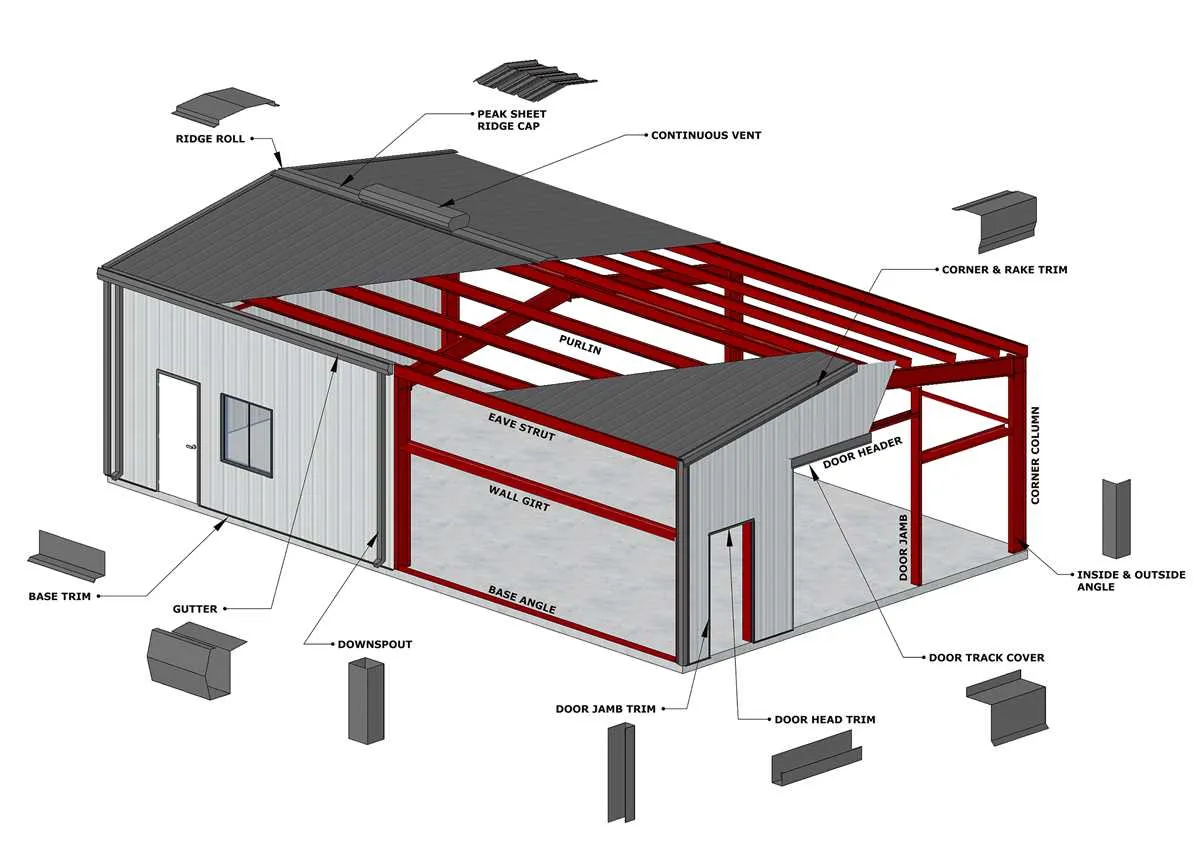
When planning the construction of a large industrial framework, understanding the essential elements and their arrangement is crucial. Focus on the foundation supports, vertical uprights, cross beams, and trusses to ensure proper alignment and load distribution. This step prevents structural failures during installation or future use.
Start with the framework, a series of vertical columns that support horizontal beams. These beams, commonly referred to as purlins and girts, work together to distribute weight evenly across the structure. The roof trusses act as a stabilizing force, ensuring the structure maintains its integrity during heavy loads or extreme weather conditions.
Each connection point between these components requires careful design. Use bolts and steel fasteners to secure critical joints, ensuring they are rated for the expected stress and strain. Pay particular attention to diagonal bracing, which adds lateral stability, particularly in taller frameworks or areas subject to wind or seismic activity.
Finally, consider the cladding and insulation, which are not only vital for energy efficiency but also protect the structure from environmental factors. Insulation panels can reduce temperature fluctuations, while the external covering serves as a shield against moisture and corrosive agents, extending the lifespan of the entire construction.
Understanding Key Structural Components and Their Functions
To ensure efficient assembly and structural integrity, it’s essential to identify and understand the primary elements involved in construction frameworks. These components include vertical supports, roof trusses, and base foundations, which are crucial for providing stability and strength. Here’s a breakdown of each element:
- Columns – Vertical supports that bear the weight of horizontal beams and roof structures, typically constructed from durable steel alloys. They should be spaced optimally to avoid excessive load-bearing.
- Girts – Horizontal members placed between columns to provide lateral support. They hold the exterior panels in place and are integral for load distribution across the frame.
- Purlins – Horizontal beams that span between trusses, supporting roof panels and aiding in distributing weight. They ensure that the roof maintains its form under pressure.
- Trusses – Triangular or rectangular frameworks that provide stability and support to the roof. These are engineered to handle heavy loads while minimizing material use.
- Bracing – Diagonal elements that prevent lateral movement and provide resistance to wind or seismic forces, ensuring the structure remains stable under stress.
- Footings – Foundation bases that distribute the weight of the entire structure. Properly sized and placed footings prevent settling or shifting over time.
For optimal performance, these components must be fabricated using materials that are resistant to environmental factors such as corrosion and wear. Regular maintenance and inspection are necessary to identify wear points and prevent failures in the structure.
- Choose corrosion-resistant materials such as galvanized steel or coated alloys.
- Ensure accurate alignment of beams and columns during assembly.
- Use proper fasteners and welds for secure connections between components.
Finally, keep in mind that correct installation of these elements is vital for achieving maximum structural efficiency and safety. Failure to address any single part could lead to complications in long-term stability.
Understanding Structural Components: Columns, Beams, and Trusses
When designing a frame, ensure that columns are placed at regular intervals to support vertical loads. These vertical elements bear the weight from the upper structure and distribute it evenly to the foundation. Choose materials with high compression strength for columns, especially when planning for taller structures.
Beams are essential for transferring loads horizontally between columns. For maximum efficiency, use beams with a high bending strength to minimize deflection and stress under load. Beams must be positioned at the proper height, allowing for clearances and accommodating the intended load distribution.
Trusses are triangular frameworks designed to provide stability and strength. Their triangular shape distributes weight efficiently, reducing the amount of material needed while maintaining structural integrity. Incorporating trusses in the roof or floor can lower material costs and increase durability.
Choosing the Right Fasteners and Connections for Metal Structures
Use corrosion-resistant materials such as stainless steel or coated alloys to ensure durability and prevent rust in exterior applications. Avoid plain steel in high-moisture environments.
Self-drilling screws with EPDM washers provide efficient sealing and eliminate the need for pre-drilling, speeding up assembly without compromising structural integrity.
For load-bearing joints, select high-strength bolts with proper torque specifications to maintain secure connections under dynamic stress. Use lock washers or thread-locking compounds to prevent loosening over time.
Rivets remain a reliable choice for joining thin gauge panels where welding is impractical; opt for aluminum or steel rivets matched to the material thickness and expected load.
When connecting framing elements, consider clip angles and specialized brackets designed for rapid installation and enhanced stability, ensuring compliance with engineering standards.
Always verify compatibility between fastener coatings and substrates to avoid galvanic corrosion, which can accelerate deterioration at contact points.
How to Read a Structural Assembly Blueprint for Easy Construction
Focus first on the legend to identify all component symbols and their specifications, including material types, dimensions, and fastening methods. Confirm the scale used to interpret measurements accurately throughout the layout.
Locate the reference points or datum lines that establish the framework’s origin for correct positioning of each element. Cross-check coordinates with elevation views to ensure proper vertical alignment.
Analyze the connection details provided at joints, paying close attention to bolt sizes, weld symbols, and overlapping sections. This clarifies the assembly sequence and required tools.
Use the section views to understand internal reinforcement and layering, especially in load-bearing zones. This prevents errors during cutting and fitting phases.
Track the numbering system assigned to components to follow the step-by-step installation order without confusion. Matching part IDs on the layout with the inventory list streamlines procurement and reduces delays.
Verify any notes on tolerances, clearances, and special instructions for handling unique shapes or coatings. Adhering to these ensures structural integrity and longevity.